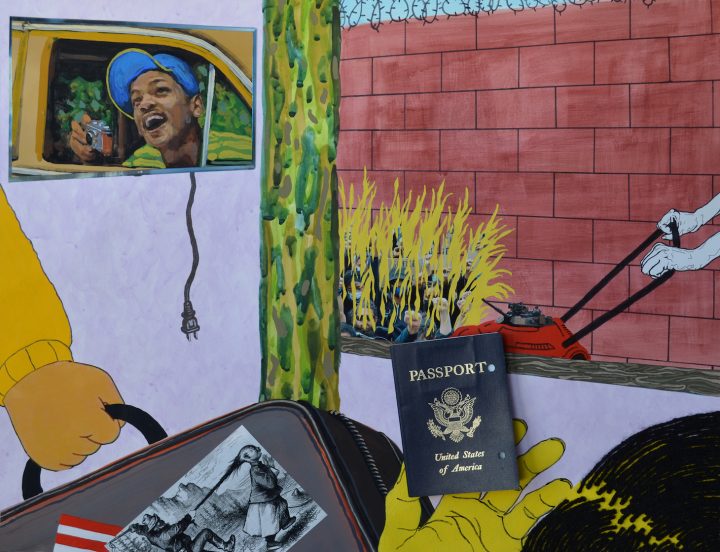
WILMINGTON, Delaware — I first saw the exhibition Yikui (Coy) Gu: Saying The Quiet Parts Out Loud at Gallery 456 in New York, which is sponsored by the Chinese American Arts Council. It was Gu’s first solo exhibition in New York. I went a few days before the exhibition closed, on May 21, 2021, but learned that it was going to reopen, with three added works, as Yikui (Coy) Gu: The Americans at the Delaware Contemporary (June 4–August 21, 2021), the artist’s first museum show.
There are 18 works in the current exhibition, all measuring 18 by 24 inches and done between 2018 and ’21. The subject is the domestic life of an interracial couple (Gu is Chinese and his wife is German) living in the United States before and during the spread of COVID-19 and the exponential rise of hate crimes against Asian Americans and Pacific Islanders. Starting this series before the pandemic, Gu examines his domestic life through the lens of the color yellow and its appearance in different circumstances.
Working on Bristol board, Gu uses acrylic, gouaches, colored pencil, ink, and charcoal, with a wide array of found materials: photographs, fabric, plastic bags, Asian and non-Asian food wrappers, printed pages of the Chinese Exclusion Act (1882). All of this gets at the disturbances flooding the daily life of the couple, living in America before and during the presidency of Donald Trump, while being surrounded by the deep, bottomless grievance of a significant portion of white America.
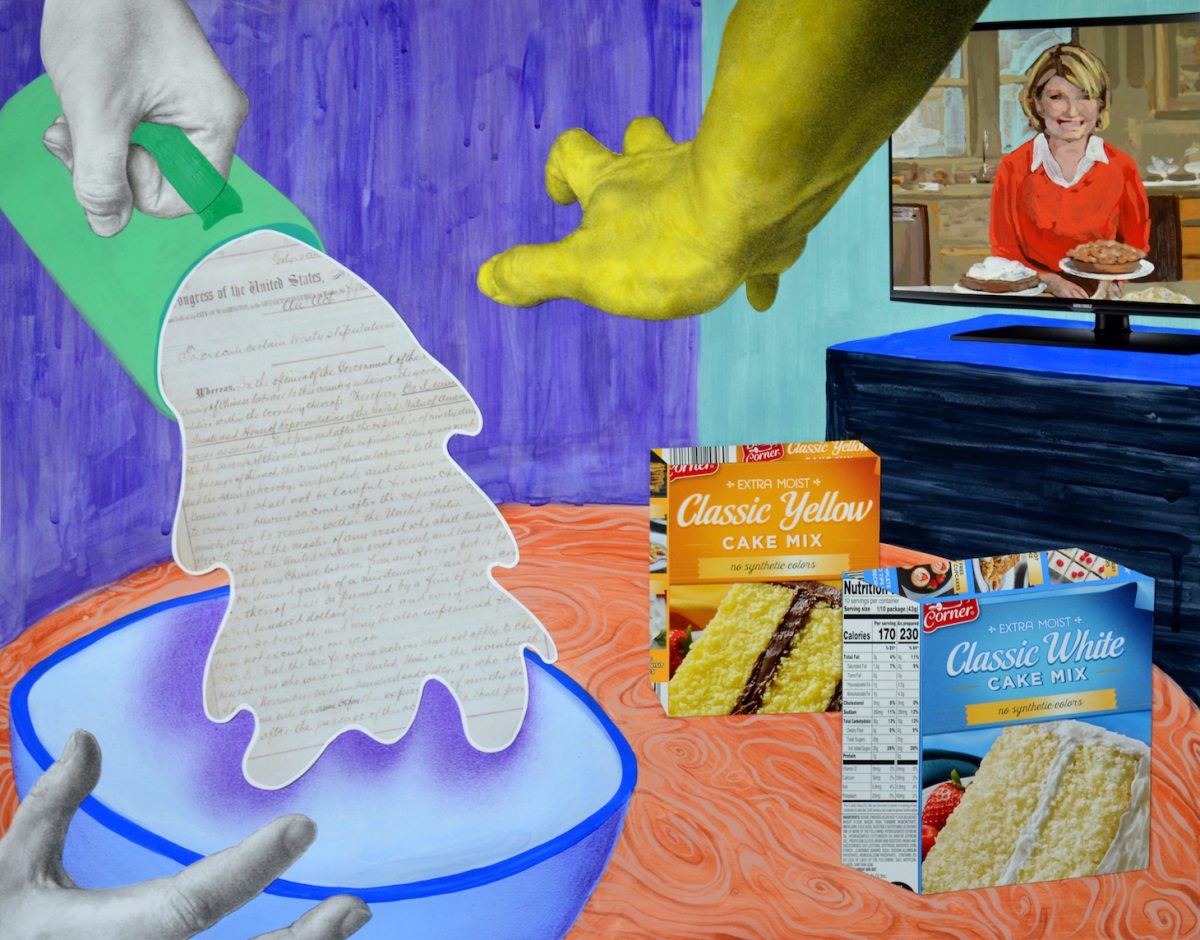
In “No Synthetic Colors” (2019), we see the hands of two people making a cake. The printed images of two white hands pour “flour” into a bowl; the flour is composed of a cutout shape containing the first page of the United States Congress’s declaration of the Chinese Exclusion Act (1882). A yellow arm reaches in from the top edge. Two boxes of cake mix with “no synthetic colors” — Classic Yellow Cake Mix and Classic White Cake Mix — are on the table beside the bowl.
This heightened awareness of one’s skin color is common to people of color living in the United States, and it is apparent in all of the exhibition’s works. Painted onto a wide screen, digital television is an image of Martha Stewart talking to her audience about the half-made layer cake in front of her. The implication is that Stewart is speaking to a white audience and is oblivious to racial divisions.
Racism is insidious because it creeps into the most mundane parts of one’s life. Gu’s use of the Chinese Exclusion Act as flour, the prime ingredient of bread, suggests that America’s long history of anti-Chinese and anti-Asian sentiment may involuntarily come to mind in what is supposed to be a happy domestic moment, and that, more broadly speaking, it impacts every aspect of his life.
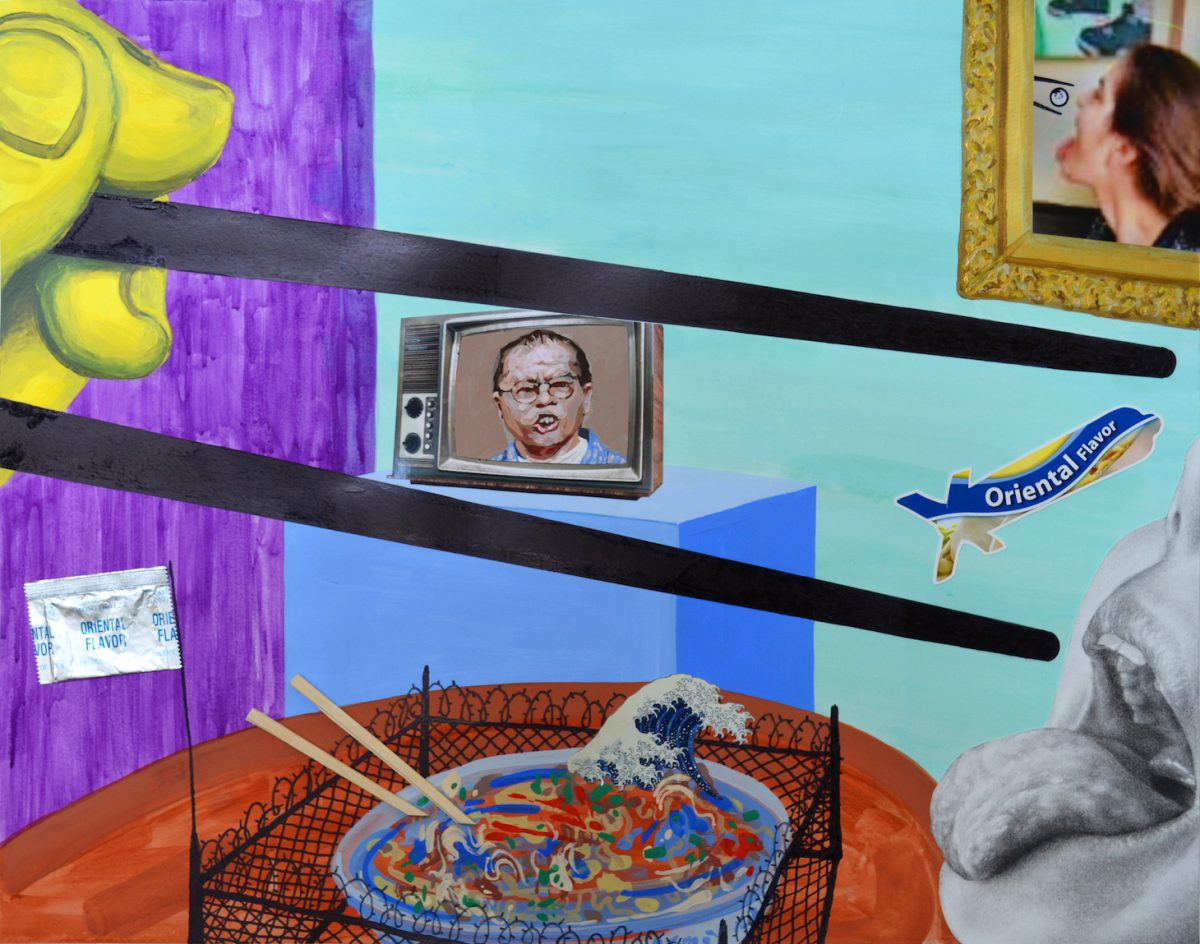
In “Oriental Flavor” (2019), actor Mickey Rooney, who seemingly enjoyed playing the racist stereotype of a bucktooth Japanese character, Mr. Yunioshi, in the film Breakfast at Tiffany’s (1961), is seen on the screen of an analog television, glimpsed between two black chopsticks. On the table we see a bowl of soup and noodles surrounded by a barbed-wire fence. A recurring motif in Gu’s work, Hokusai’s “Great Wave” rises out of the soup, suggesting an inescapable cataclysm is approaching. Condiment wrappers with the words “Oriental Flavor” are affixed to the scene.
While Gu could have found a reproduction of Rooney as Mr. Yunioshi, I think it is telling that he painted the portrait to fit inside the TV screen. The play between what is painted and drawn and the use of readymade reproductions are devices he uses throughout his work. By painting this racist representation, Gu is able to take possession of it.
There is nothing subtle about Gu’s work: it is in your face because the racism he encounters is always there. I will never be able to look at a yellow smiley face or other yellow emoji in quite the same irked way as I once did.
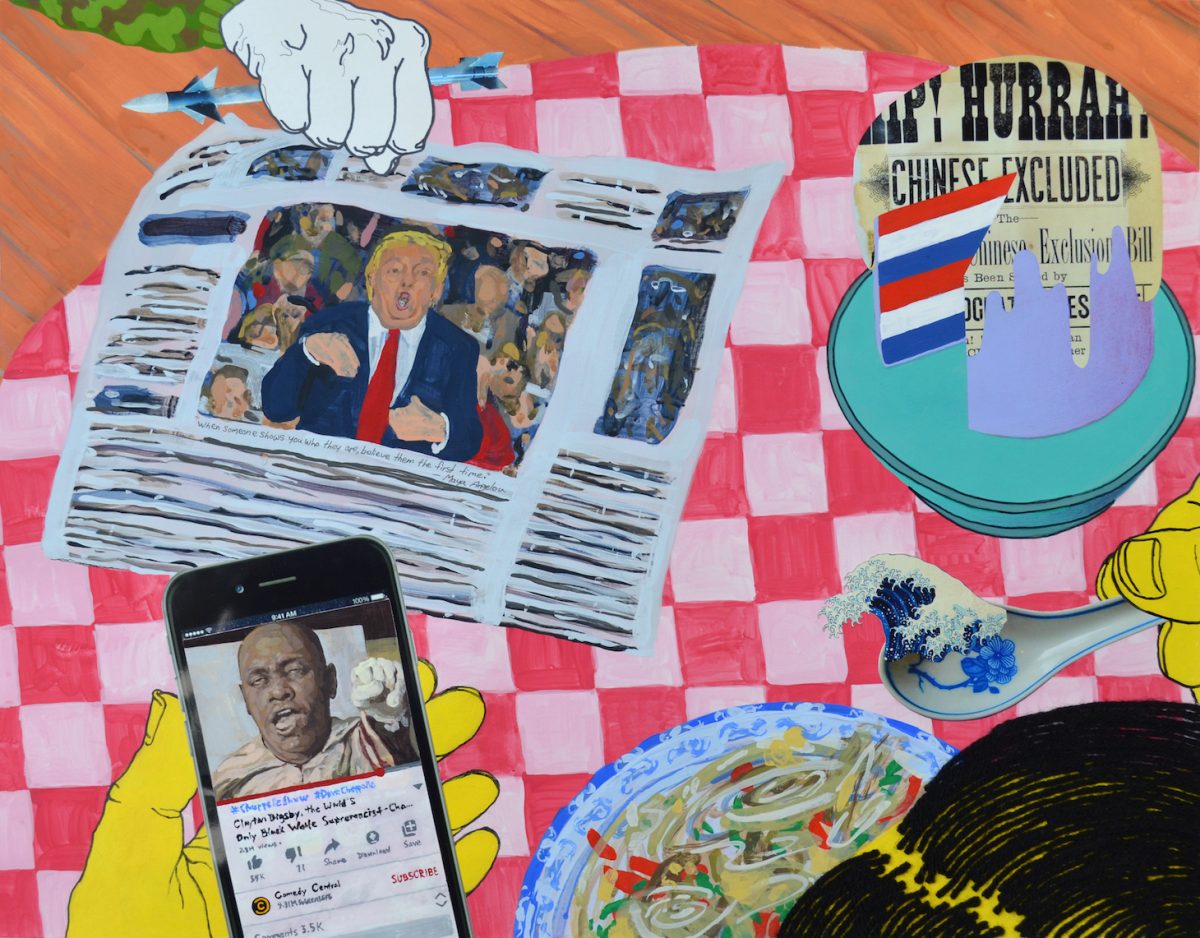
The presence of cell phones, digital screens, newspapers, labels, and packaging in Gu’s art underscores the ubiquity of racist representation and language in everyday life. If agreement is an essential component of our use of language, and perhaps even civility, Gu recognizes that we exist in a state of disagreement bordering on chaos, and knows that it is not clear which way the country is headed.
We see the headline of then-presidential candidate Trump mocking the New York Times reporter Serge Kovaleski for his disability in 2016. This and other despicable acts did not stop him from winning the election. Beneath Gu’s painted image of the front page, picturing the mocking Trump, is the line: “When someone shows you who they are, believe them the first time” (Maya Angelou).
On a cell-phone screen below the newspaper, we see comedian Dave Chappelle playing the character “Clayton Bigsby, the World’s Only Black White Supremacist.” On the right part, a collaged headline celebrates the passing of the Chinese Exclusion Act. Gu also knows that in the world in which he exists Asians are either excluded or invisible.
A lot has been written about artists who have carried on the legacy of political collage, as exemplified by Dada artists such as Hannah Höch and John Heartfield. Gu’s play with the painted image and printed material is inventive and unsettling, and his juxtapositions and recontextualizing of language open up an area of racial consciousness that has not been widely recognized or explored in art. He recognizes the role that sharp, edgy humor can play in his work.
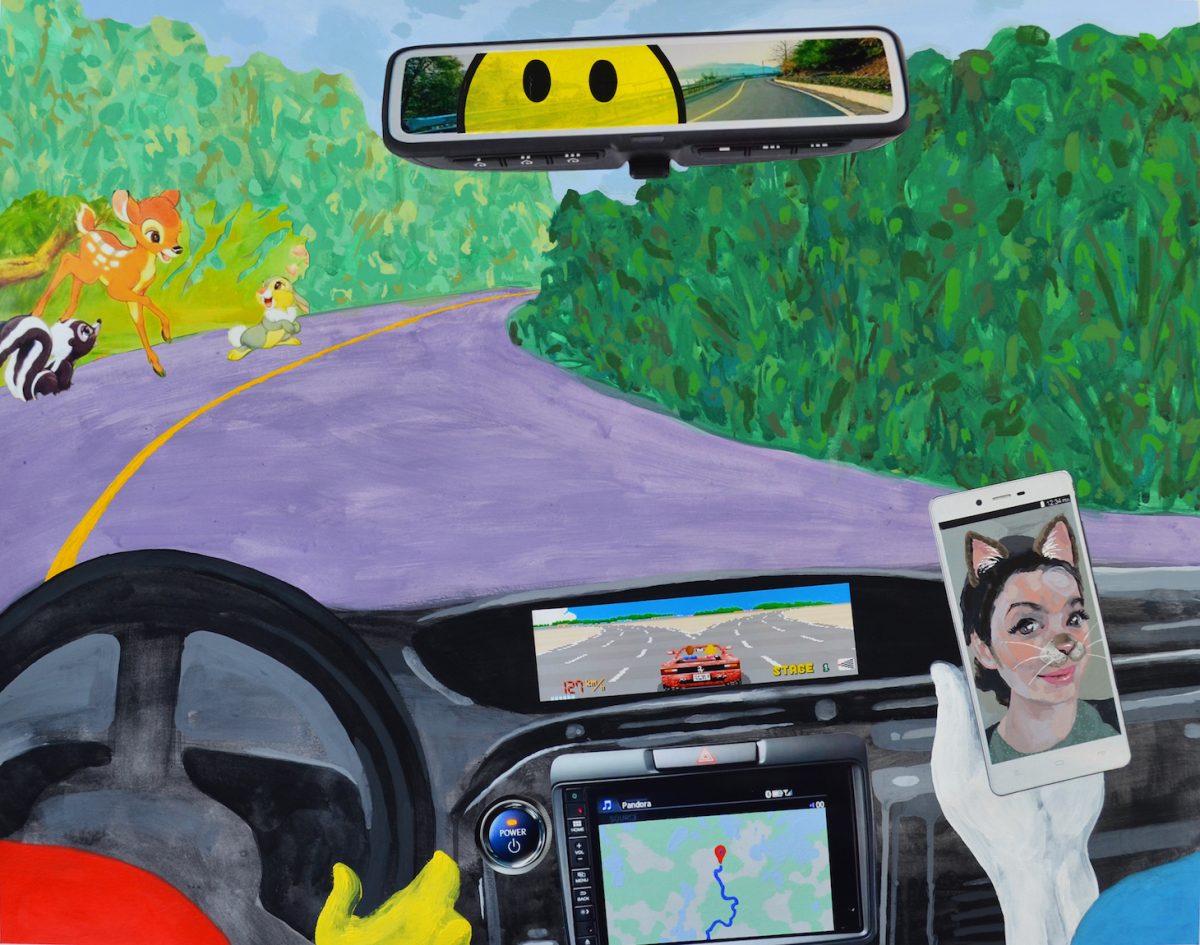
Another striking thing about these works is the attention Gu pays to every part of the composition, from the perspective looking into the scene to the collaged materials. There is an unnerving dissonance to the collaged elements he disperses within his works. In “The Scenic Route” (2019), the view is a car’s front windshield and the road ahead, as seen from someone behind the two people seated in the front of the car, and only partially visible to the viewer. Why do we see the eyes of a smiley face in the rearview mirror? Is this a stand in for the emasculated Asian male, all of whom presumably look alike? What are the three Disney animals doing by the side of the two-lane road? What should we make of the face of a young woman with cat ears, nose, and whiskers on the cell phone held by the front-seat passenger?
Walt Disney, who didn’t trust women or cats, did not want to hire minorities at Disneyland amusement parks, and used racial stereotypes in a number of his films, including Fantasia (1940) and Song of the South (1946), which the Disney Corporation decided was too racist to include on its streaming service, Disney+.
Is America’s scenic route a view of Disney’s films and cartoons made while Walt Disney was alive? What falsities and stereotypes might we find at Disneyland?
Anger, disgust, worry, tenderness, determination, sharp satirical humor, a keen eye for society’s use of language, and an awareness of history and popular culture are apparent in Gu’s work. He touches on the subjects of Asian stereotypes and racism, which have seldom been addressed in contemporary American art. I look forward to seeing where else he takes me, no matter how upset I might become.
Yikui (Coy) Gu: The Americans continues at the Delaware Contemporary (200 South Madison Street, Wilmington, Delaware) through August 21.
0 Commentaires